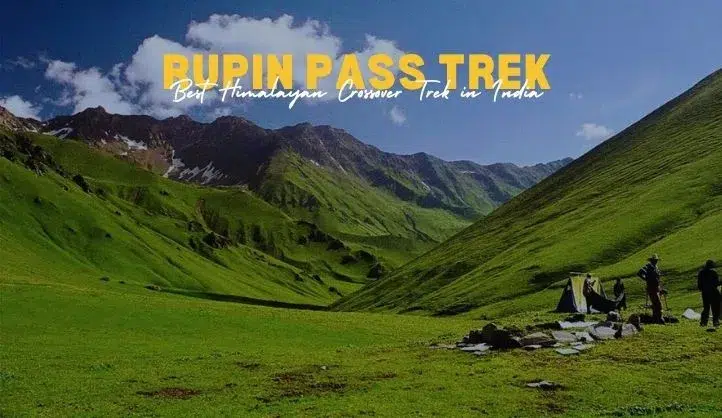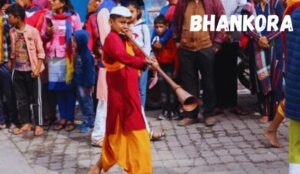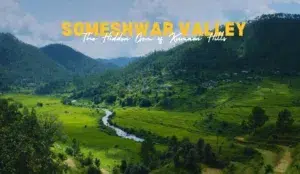Have you ever dreamed of walking from one state to another through high mountains, tall waterfalls, green meadows, and snowy paths—all in one trek? If yes, then the Rupin Pass trek is perfect for you.
Rupin Pass is one of the most beautiful and exciting treks in the Indian Himalayas. It takes you from the peaceful villages of Uttarakhand to the lovely valleys of Himachal Pradesh, crossing a high mountain pass at 4,650 meters. This trek is full of surprises—every turn brings a new view. One moment you’re walking through pine forests, and the next you’re standing beside a huge waterfall or crossing a snow bridge.
The Rupin Pass trek is not just a walk in the mountains. It is a journey through changing landscapes, local cultures, and thrilling challenges. It is one of those treks that makes you fall in love with the Himalayas all over again.
In this blog, we will share everything you need to know about the Rupin Pass trek—route, weather, day-by-day itinerary, fitness tips, packing list, how to reach, prices, safety, and more. If you are planning your next Himalayan adventure, keep reading.
Fast Facts
| Fact | Number |
|---|---|
| Highest point | 4,650 m / 15,250 ft |
| Trek distance | 40–41 km (varies by campsite) |
| Days on trail | 7 – 8 days |
| Difficulty | Moderate–difficult |
| Best months | May‑June & Sept‑Oct (clear paths, bright skies) |
Where is the Rupin Pass Trek Located
The Rupin Pass trek is located in the Indian Himalayas, starting in Uttarakhand and ending in Himachal Pradesh. The trek begins from a small village called Dhaula in the Uttarkashi district of Uttarakhand. From there, the trail goes through forests, rivers, and meadows before reaching the high-altitude Rupin Pass, which lies at 4,650 meters. After crossing the pass, the trek ends at Sangla, a beautiful village in the Kinnaur region of Himachal Pradesh.
Rupin Pass lies inside the Govind Pashu Vihar National Park, which is known for its natural beauty and rare wildlife. This trek gives you the experience of two different states, cultures, and landscapes—all in one journey.
What Makes Rupin Pass Special
1. A High-Altitude Himalayan Pass
Rupin Pass is a high mountain pass located in the Himalayas, on the border of Uttarakhand and Himachal Pradesh. It connects two stunning valleys—Rupin Valley in Uttarakhand and Baspa Valley in Himachal. The pass sits at an altitude of about 4,650 meters (15,250 feet) above sea level and is known for its dramatic landscapes, steep climbs, and thrilling snow crossings. It is one of the most loved treks in India for both beginners and experienced trekkers.
2. The History Behind the Trail
Before becoming a popular trekking route, Rupin Pass was used by local villagers, shepherds, and traders to move between the two regions. It was a lifeline for people living in remote mountain villages, especially during the summer months when other routes were blocked by snow. Today, the trail still carries that old-world charm—you may see locals carrying firewood, cattle walking ahead of you, or small wooden temples along the path.
3. The Trek That Changes Every Day
Unlike many treks that offer the same views every day, Rupin Pass is known for its ever-changing scenery. You begin your walk in thick green forests filled with birds and flowers. As you climb higher, you cross hanging wooden bridges, walk along rivers, pass ancient villages, and camp under a giant waterfall. Higher up, you trek over wide meadows, snowfields, and rocky patches. Every day on this trek feels fresh, new, and exciting. It keeps you curious and makes the journey feel short, even if it’s long.
4. A Unique Crossover Adventure
Rupin Pass is one of the few “crossover treks” in India. This means you start in one state—Uttarakhand—and end in another—Himachal Pradesh. You begin at Dhaula, a quiet village in Uttarakhand, and finish the trek at Sangla, a lively town in Himachal. This crossover not only gives you changing views but also different cultures, homes, food styles, and landscapes. It’s like visiting two different worlds in just one trek.
5. A Journey to Remember
More than a trek, Rupin Pass is a complete experience. It has adventure, peace, beauty, culture, and challenge—all in one. You will walk long paths, see places only a few people have seen, sleep under open skies, and make memories that will last forever. It is not just about reaching the pass—it’s about everything you see and feel on the way. That’s why trekkers often say, “Rupin Pass changes you.”
Best Time to Do the Rupin Pass Trek
The best time to do the Rupin Pass trek is during two seasons—summer (May to June) and post-monsoon (September to mid-October). These months offer the safest trail conditions and the best mountain views.
1. May to June (Summer Season)
This is one of the most popular times for the trek. The snow from winter starts melting, creating beautiful snow bridges, flowing streams, and green meadows. You’ll still see some snow near the pass, which makes the trek exciting but safe. Wildflowers begin to bloom, and the waterfalls are full and powerful.
Why choose this time:
-
Snow patches are still present for adventure
-
Waterfalls and rivers are active
-
The weather is pleasant in most campsites
-
Great time for photography
2. September to Mid-October (Autumn Season)
This is another great time for trekking. After the monsoon ends, the sky becomes clear and the air feels fresh. The meadows turn golden, and the entire trail looks clean and peaceful. It’s also less crowded compared to the summer season.
Why choose this time:
-
Crystal clear mountain views
-
Fewer trekkers on the trail
-
Dry and stable weather
-
Beautiful golden landscapes
Avoid July and August
Monsoon months are not safe for the Rupin Pass trek. There are high chances of landslides, slippery trails, and leeches in the lower regions. Most trekking companies, including WanderSky, do not run batches during this time.
Rupin Pass Trek – Day by Day Itinerary
The Rupin Pass trek usually takes 7 to 8 days to complete. Below is a detailed day-wise itinerary that includes distances, altitude gain, and highlights for each day.
1. Day 1: Drive from Dehradun to Dhaula
-
Distance: ~200 kilometers
-
Time: 9 to 10 hours
-
Route: Dehradun – Purola – Mori – Dhaula
-
Stay: Overnight in tents/homestay at Dhaula
Highlights:
Your journey begins with a beautiful drive along the Tons River through pine forests and mountain villages. Dhaula is a quiet riverside village where the trek begins the next day.
Day 2: Trek from Dhaula to Sewa
-
Distance: ~11 km
-
Time: 5 to 6 hours
-
Altitude Gain: 1,920 meters
-
Stay: Campsite near the village
Highlights:
The trail moves through fields, rhododendron trees, and small hamlets. You’ll pass through a mix of forest and open land. At Sewa, don’t miss the small wooden temple with a beautiful hanging bell. This day is a good warm-up.
Day 3: Trek from Sewa to Jhaka
-
Distance: ~14 km
-
Time: 6 to 7 hours
-
Altitude Gain: 2,680 meters
-
Stay: Camp at or near Jhaka
Highlights:
The path becomes steeper today. You’ll cross the Rupin River on a hanging wooden bridge and walk along cliff-side trails. Jhaka is famously called the “hanging village” because it seems to be built on the edge of the mountain.
Day 4: Trek from Jhaka to Saruwas Thatch
-
Distance: ~7 km
-
Time: 5 to 6 hours
-
Altitude Gain: 3,000 meters
-
Stay: Camp at Saruwas Thatch
Highlights:
The trail takes you through thick forests filled with fir, pine, and maple trees. As you go higher, you will start seeing snow patches, and the landscape becomes more alpine. Saruwas Thatch is a peaceful green meadow perfect for resting.
Day 5: Trek from Saruwas Thatch to Dhanderas Thatch
-
Distance: ~3 km
-
Time: 2 hours
-
Altitude Gain: 3,500 meters
-
Stay: Camp at Dhanderas
Highlights:
Today’s trail is full of views—giant waterfalls, wide valleys, and snow bridges. Dhanderas Thatch is a large, open campsite located right below the famous Rupin waterfall. A great place for photography and short hikes.
Day 6: Trek from Dhanderas Thatch to Upper Waterfall Camp
-
Distance: ~2 km
-
Time: 2 to 3 hours
-
Altitude Gain: 4,000 meters
-
Stay: Camp at Upper Waterfall
Highlights:
This is a short but steep climb beside the Rupin waterfall. You’ll walk on rocky terrain and cross snow patches. The campsite is located at the foot of the final climb to Rupin Pass. The night sky here is full of stars!
Day 7: Cross Rupin Pass – Trek to Ronti Gad
-
Distance: ~10 km
-
Time: 8 to 9 hours
-
Altitude Gain: 4,650 → 3,800 meters down
-
Stay: Camp at Ronti Gad
Highlights:
This is the most thrilling day of the trek! You will climb up a steep snow-filled gully to reach Rupin Pass—the highest point of the trek. From the top, you’ll get a 360-degree view of snowy peaks. After enjoying the view, descend carefully to Ronti Gad, a quiet meadow in Himachal.
Day 8: Trek from Ronti Gad to Sangla
-
Distance: ~11 km
-
Time: 5 to 6 hours
-
Descent: ~2,700 meters
-
Stay: Trek ends, you can stay at a hotel in Sangla
Highlights:
This is the last day of your trek. The trail goes through small streams, forests, and then joins a wide motor road near Sangla. The Baspa Valley views are stunning. Once you reach Sangla, you can explore the market, eat at local cafes, or take a ride to Shimla or Chandigarh.
Summary Table
| Day | Route | Distance | Time | Altitude (m) |
|---|---|---|---|---|
| 1 | Dehradun → Dhaula (drive) | 200 km | 10 hr | 1,580 |
| 2 | Dhaula → Sewa | 11 km | 5–6 hr | 1,920 |
| 3 | Sewa → Jhaka | 12 km | 6–7 hr | 2,680 |
| 4 | Jhaka → Saruwas Thatch | 7 km | 5–6 hr | 3,000 |
| 5 | Saruwas → Dhanderas Thatch | 3 km | 2–3 hr | 3,500 |
| 6 | Dhanderas → Upper Waterfall | 3 km | 2–3 hr | 4,000 |
| 7 | Upper Camp → Rupin Pass → Ronti Gad | 10 km | 8–9 hr | 4,650 → 3,800 |
| 8 | Ronti Gad → Sangla | 11 km | 4–5 hr | 2,700 |
Note:
The trek distances, time taken, and altitude mentioned in this itinerary are approximate and may vary slightly depending on weather, trail conditions, campsite changes, and individual fitness levels. Always follow your trek leader’s instructions and stay flexible with the plan.
How Difficult is the Rupin Pass Trek
The Rupin Pass trek is a moderate to difficult level trek. It needs good fitness and mental strength. Here’s what you should know:
1. Trekking Hours
-
You will walk 5 to 7 hours daily on most days.
-
The trail includes uphill, downhill, and rocky paths.
-
Some parts are narrow, steep, or beside cliffs.
2. High Altitude
-
The highest point is Rupin Pass at 4,650 m (15,250 ft).
-
At high altitudes, oxygen is lower, which may cause breathlessness or headaches.
-
Walk slowly and take regular water breaks.
3. Snow and Steep Sections
-
You will cross snow patches and steep slopes, especially near the pass.
-
Micro-spikes and trekking poles are often needed (usually provided).
-
Trails can be slippery, so good shoes are a must.
4. Carrying Load
-
Carrying a heavy backpack (8–10 kg) can make the trek harder.
-
You can hire a porter or mule to carry your bag if needed.
5. Who Can Do This Trek
-
Beginners: Yes, if you prepare in advance.
-
Teens (12+): Yes, if active and used to walking.
-
Seniors: Possible, if medically fit and experienced with hills.
How to Prepare for the Rupin Pass Trek
| Focus Area | Activity |
|---|---|
| Cardio (Stamina) | • Walk or jog for 30–45 mins daily • Use stairs instead of lifts • Weekend hikes with light backpack (2–3 kg) |
| Leg Strength | • 20–30 bodyweight squats • 10–15 lunges (each leg) • 30 step-ups on stairs or bench |
| Core & Balance | • Plank: 30 seconds × 2 sets • Seated core twists: 20 reps |
| Flexibility | • Stretch legs, back, shoulders after workouts • Gentle yoga or basic warm-ups |
| Hydration and Rest | • Drink enough water daily • Sleep 7–8 hours every night • Take rest days if needed |
Note:
You don’t have to do heavy workouts or intense training, but a little bit of physical preparation is important. Regular walking, simple exercises, and staying active will make your Rupin Pass trek much easier and more enjoyable.
What to Pack for the Rupin Pass Trek
| Category | Items to Pack |
|---|---|
| Clothing | • 2 quick-dry T-shirts • 1 warm fleece or thermal layer • 1 down or padded jacket • Rain jacket or poncho • Woollen cap, gloves, and neck buff |
| Footwear | • High-ankle trekking shoes (water-resistant) • 2–3 pairs of wool or sports socks |
| Trekking Gear | • Backpack (50–60L) with rain cover • Trekking poles • Headlamp with extra batteries |
| Water & Hydration | • Two 1-liter water bottles or a hydration bladder |
| Electronics | • Power bank for phone or camera |
| Health & Safety | • Basic personal medicines • Diamox (only after doctor’s advice) • Any first-aid items you may need |
| Optional Extras | • Micro-spikes • Light snacks or energy bars |
Rupin Pass Trek Cost Breakdown
| Category | Details | Estimated Cost (INR) |
|---|---|---|
| Trekking Package | 7–8 days trek with guide, meals, tents, permits, gear | ₹16,000 – ₹20,000 |
| Travel to Base Camp | Dehradun → Dhaula & Sangla → Shimla/Delhi (shared cabs) | ₹3,000 – ₹4,000 |
| Personal Gear Rentals | Jacket, trekking shoes, poles (if not bringing your own) | ₹500 – ₹1,000 |
| Snacks & Energy Bars | Dry fruits, chocolates, ORS packets | ₹300 – ₹500 |
| Porter or Mule (Optional) | ₹350–₹500 per day × 6–7 days | ₹2,000 – ₹3,500 |
| Misc. Expenses | Tips, camera charging, café snacks, buffer money | ₹500 – ₹1,000 |
| Total Estimated Cost | — | ₹20,000 – ₹26,000 |
Rupin Pass Trek Package by WanderSky
Join WanderSky for a safe, scenic, and fully guided Rupin Pass trek with everything you need included in one simple package.
What’s Included:
-
7N/8D guided trek from Dhaula to Sangla
-
All meals during the trek (veg, hot & fresh)
-
Tents, sleeping bags, mats, and basic safety gear
-
Forest permits and entry fees
-
Support team: guides and helpers
-
Micro-spikes and trekking poles (in snow season)
-
Group pickup from Dehradun (optional add-on)
What’s Not Included:
-
Travel from your city to Dehradun
-
Meals during a road journey
-
Personal porter/mule (available on request)
-
Rentals (shoes, jackets – optional)
💰 Starting Price: ₹18,499 per person
Group discounts available for 5+ people
Tips for a Safe Trek
The Rupin Pass trek is beautiful but also challenging. A little care and preparation can keep you safe and comfortable throughout the journey.
1. Wear Your Shoes Before the Trek
Use your trekking shoes for a few days to avoid blisters.
2. Drink Water Often
Keep sipping water, even if you’re not thirsty.
3. Walk Slowly
Go at your own speed. Don’t rush or run.
4. Keep Your Bag Light
Pack only what you need. A light bag is easier to carry.
5. Listen to the Guide
Follow all instructions from your trek leader.
6. Watch for Altitude Sickness
If you feel dizzy or weak, rest and tell your guide.
7. Stay Warm & Dry
Wear layers. Always keep one pair of dry socks.
8. Save Phone Battery
Switch off your phone when not in use. Carry a power bank.
9. Carry Basic Medicines
Pack personal medicines and a small first-aid kit.
10. Respect Nature & People
Don’t litter. Be kind to locals and fellow trekkers.
Stay Options After the Trek – Sangla, Himachal Pradesh
1. Batseri Village Homestay
-
Location: Batseri, near Sangla
-
Starting Price: ₹1,200/night
2. Prakash Regency, Sangla
-
Location: Near Sangla main market
-
Starting Price: ₹1,000/night
-
Google Maps: Hotel Prakash Regency
3. Hotel Apple Pie Sangla
-
Location: Sangla Village
-
Starting Price: ₹1,500/night
4. Banjara Camps & Retreats (Luxury)
-
Location: Batseri, Sangla
-
Starting Price: ₹4,500/night (including meals)
5. Hotel Rupin River View
-
Location: Near Baspa River, Sangla
-
Starting Price: ₹2,200/night
✅ Note: Prices may change during the season. Always confirm while booking. And book in advance during peak season.
Conclusion
The Rupin Pass trek is not just a trek—it’s a journey across two beautiful Himalayan states, filled with waterfalls, hanging villages, deep forests, snow bridges, and mountain views you’ll never forget. It’s perfect for adventure lovers who want something different from the usual tourist trails.
But this trek is also challenging. You’ll need the right fitness, proper planning, and a trusted team to guide you safely. That’s where WanderSky comes in.
With all-inclusive packages, experienced guides, and local knowledge, WanderSky takes care of everything, so you can simply walk, explore, and enjoy the magic of the mountains.
👉 Ready to experience the Rupin Pass trek?
Book your spot now with WanderSky and turn your Himalayan dream into reality.
Frequently Asked Questions (FAQs)
1. Is the Rupin Pass trek good for first-timers?
Yes, first-time trekkers can do it with proper fitness and preparation.
2. Do I need a guide for the Rupin Pass trek?
Yes, having a guide is important for safety and route navigation.
3. Is a permit required for the Rupin Pass trek?
Yes, but WanderSky includes all permits in the trek package.
4. Is there a mobile network on the Rupin Pass route?
No, the mobile signal is weak after Dhaula and usually unavailable during the trek.
5. Will there be snow during the Rupin Pass trek in June?
Yes, you’ll cross small snow patches near the pass in early summer.
6. What is the minimum age for this trek?
The trek is suitable for anyone above 12 years with good fitness.
7. Are toilet tents provided during the trek?
Yes, clean dry-pit toilet tents are set up at all campsites.
8. Is drinking water safe on the trek?
Yes, filtered or boiled stream water is provided at campsites.
9. Can I exit the trek early if needed?
Yes, an early exit is possible via Jiskun by Day 3.
10. Are drones allowed on the Rupin Pass trek?
No, drones are not allowed due to forest rules and wildlife zones.
11. Is the food vegetarian during the trek?
Yes, all meals during the trek are simple, healthy, and vegetarian.
12. What documents are needed for the Rupin Pass trek?
You need to carry a valid photo ID (Aadhaar/Passport) and 2 passport-size photos for permits.





